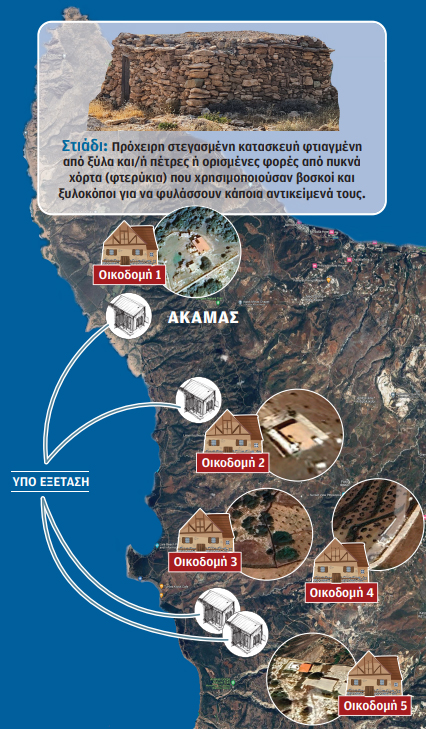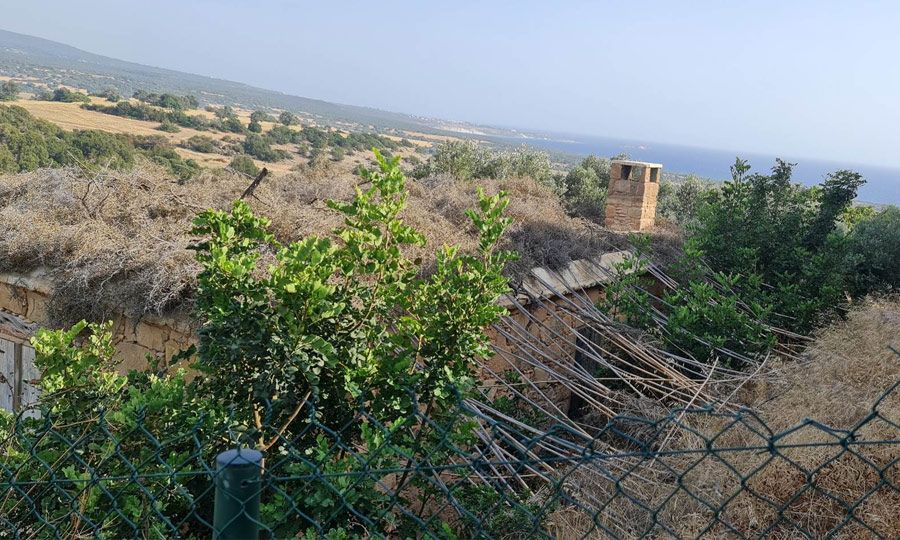

Apostolos Tomaras
Several months prior to the scheduled implementation of the Akamas plan, stone buildings are emerging in the heart of the forest, completely unrelated to livestock housing, which abounds in the surrounding area. These stone structures undoubtedly constitute illegal interventions within an area where the placement of even a single stone has been prohibited since the early 1980s, according to local residents. An investigation conducted by "K" has uncovered a minimum of eight such unlawful interventions within the heart of Akamas, involving the construction or conversion of old, makeshift livestock shelters into vacation homes. The identified cases, as indicated on the area's map, are even visible through satellite imaging, notably on the well-known platform Google Earth. In one instance, "K" presents photographic evidence clearly depicting the construction of a ground-floor stone house near Lara Beach, which in no way resembles a makeshift cattle shelter or stable. The photographs reveal that the structure is intended for residential use. Notably, the owner of this particular property has enclosed the area, transforming it into a garden with trees, while also placing dry branches on the roof to potentially evade detection by satellite imagery—technology employed by governmental agencies. Some instances of these illegal interventions in Akamas have come to the attention of the competent authorities, with necessary actions being taken in at least two cases, pending court decisions on subsequent actions to be taken. The owner had security fenced the lot with controlled entry and barbed wire, which is strictly prohibited in the area.
The owner had security fenced the lot with controlled entry and barbed wire, which is strictly prohibited in the area.
The eight illegalities
It is evident that the buildings in these eight cases do not align with the architectural styles present in the area since the 1800s. The Planning Department has confirmed that two of the eight instances of ground-floor construction are situated within the administrative boundaries of the Inia municipality. According to official reports from the Planning Department, on-site inspections were conducted during the pandemic period in response to complaints. An official from the Planning Department, accompanied by an engineer and an Environment Department representative, visited the Akamas area and discovered that both cases involved the completion of two houses that had no resemblance to livestock stews. The Planning Department asserts that these constructions were erected in a restricted development zone. As for the remaining six cases of building erection, there is no information available regarding whether they involved repairs to existing structures or their conversion into dwellings.
In courts
The implicit legalization of their renovation and conversion may serve as a loophole for the construction of numerous cottages.
Based on an official update provided by the Planning Department, it was revealed that after conducting on-site inspections, the department identified the land owners where the residential houses were constructed through the Land Registry. Subsequently, an enforcement notice was issued, stating that if the dwelling is not demolished or the construction work was terminated, legal action would be pursued. This course of action has already been taken in the two specific cases involving dwellings within the administrative boundaries of the municipality of Inias. The Planning Department further reported that after a period of 30 days, they sent a letter to the Legal Department, requesting criminal action. Currently, the two cases are under adjudication.
Like the 'Trojan Horse'
Based on the investigation conducted by the Planning Department, it was discovered that an attempt was made to obtain a permit through the Paphos District Administration. Prior to issuing an enforcement notice, the Planning Department received information indicating that the parties involved had submitted an application for the improvement of roadside gardens in the two areas of Akamas, claiming that they were old livestock sheds in need of renovation. The application even included photographs as supporting evidence. However, these claims were not substantiated during the inspection conducted by the Planning Department. Specifically, a thorough examination of the Land Registry and cadastral maps, spanning from 1923 to 1974, failed to identify any existing structures in the aforementioned areas, leading the officials of the Planning Department to conclude that these were indeed new buildings. Additionally, according to information provided by "K", in one of the two cases, the land had been acquired by a third party who, for undisclosed reasons related to the construction work evident in "K's" photographs, does not appear in the property records. Furthermore, in one instance, the landowner went so far as to erect fencing and build a house measuring approximately one hundred (100) square meters, featuring a fireplace—an element strictly prohibited in the area. Additionally, a watering system was installed within the newly created garden.
Visible from high above
The investigation conducted by "K" has revealed that one of the renovated livestock stews (referred to as Building 4) has been transformed into a permanent residence. According to information obtained by "K," the owner of this property is allegedly a former government official. However, another building (referred to as Building 1), which is clearly visible in satellite photos possessed by "K," is situated in the "Geronissos" area deep within the Akamas forest park. Surprisingly, this building does not seem to have garnered the attention of government agencies.
Sources within the state services, speaking on the condition of anonymity to "K," have highlighted the concerning practice of implicitly tolerating the renovation of livestock stews and their subsequent conversion into small-scale residences or holiday homes. This practice poses a significant risk of facilitating the construction of numerous holiday farms within the restricted zone of Akamas.
The Mayor of Ineia
Regarding the two cases currently being adjudicated, "K" reached out to Mr. Yago Tsiviko, the mayor of Ineia. The mayor of the community vehemently refuted any claims of building conversions or new constructions within the Akamas area, which falls under his community's administrative boundaries. However, he did acknowledge that if someone had undertaken repairs or restoration work on a "styadi," it did not amount to the creation of a lavish mansion. Rather, it was simply the refurbishment of an existing livestock shelter that had stood for 200 years, mostly made of traditional braided materials. The mayor clarified that the "styadias" were multifunctional spaces utilized for both housing and livestock purposes. According to the community leader, Ineia had a substantial number of over 1,000 "styadias" in the past. Dry branches have been placed on the roof apparently to avoid being detected by satellite imagery, a technology used by government agencies, while a fireplace has also been built, which is strictly prohibited in Natura 2000 zones.
Dry branches have been placed on the roof apparently to avoid being detected by satellite imagery, a technology used by government agencies, while a fireplace has also been built, which is strictly prohibited in Natura 2000 zones.
[This article first appeared in Kathimerini's printed Sunday edition and was translated from its Greek original]































